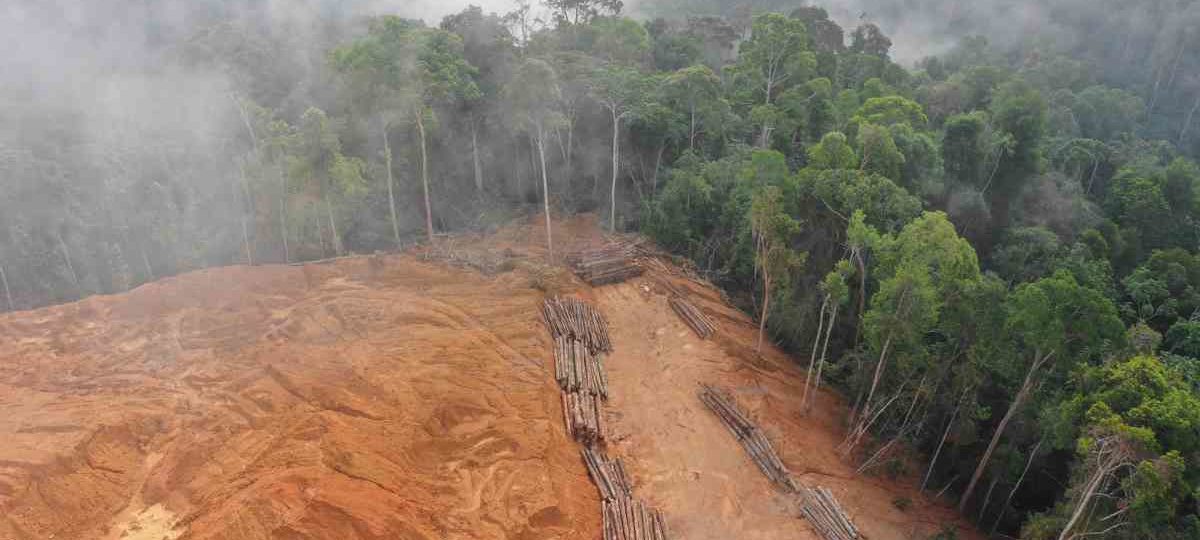From the disappearance of species to the disruption of water cycles. Understanding these consequences can help us better understand how we can conserve our forests.
List of 15 Environment Effect of Deforestation
1. Global Warming and Climate Change
Global warming and climate change are two of the most pressing environmental issues that are caused by deforestation. The loss of forests leads to an increase in carbon emissions, which exacerbates global warming. In addition, deforestation reduces the ability of forests to absorb carbon, making them less effective in mitigating climate change. Furthermore, deforestation leads to an increase in air pollution, as well as a decrease in biodiversity and a reduction of natural habitats.
These combined effects contribute to the deterioration of our environment and the worsening of global warming and climate change.
2. Air Pollution
Deforestation has a serious and direct effect on air pollution. Trees absorb carbon dioxide and other pollutants from the air, helping to clean the air we breathe. As forests are lost, the amount of pollutants in the air increases, leading to an increase in the amount of smog, acid rain, and other forms of air pollution.
This is especially true in areas near large cities where deforestation has occurred, as there is less vegetation to act as a buffer between the urban environment and its inhabitants. The loss of trees can also lead to a decrease in oxygen levels, which can have serious health implications for humans and animals alike.
3. Loss of Biodiversity
Deforestation has a devastating impact on biodiversity, as it leads to species losing their natural habitats. More than three-quarters of the world’s documented land-based species can be found in forests, so when species lose their forest homes, they are greatly at risk. Additionally, deforestation can lead to reduced genetic diversity and increased vulnerability to extinction.
As different species are dependant on each other for survival, the loss of a single species can cause a chain reaction that adversely affects the entire ecosystem. This not only impacts the environment directly, but also humans as we rely on healthy ecosystems to provide us with food, water and other resources. Therefore, it is vital that we take action to protect our forests and help conserve life on land.
4. Reduced Carbon Sink
Deforestation has a major effect on the environment, including reducing the amount of carbon that is stored in the atmosphere. Forests act as natural carbon sinks, absorbing carbon dioxide from the atmosphere and locking it away in the plants, soils, and trees. When these forests are cut down and burned, this stored carbon is released back into the atmosphere, contributing to global warming and climate change. This loss of trees also reduces the amount of carbon dioxide that can be absorbed naturally from the atmosphere, leading to higher levels of atmospheric carbon dioxide and furthering climate change.
Deforestation also reduces the ability of forests to act as natural buffers against floods and droughts, further compounding its effects on the environment.
5. Increased Carbon Emissions
Deforestation has led to a dramatic increase in carbon emissions, making it one of the leading causes of global warming.
Trees and plants absorb carbon dioxide from the atmosphere during photosynthesis, but when forests are cleared, these carbon sinks are lost and more carbon dioxide is released into the air. As a result, deforestation is responsible for around 15% of all greenhouse gas emissions. In addition, burning forests to clear land releases even more carbon dioxide into the atmosphere, further exacerbating the effects of deforestation on climate change. Although forest conservation efforts have been put in place to reduce deforestation and its impacts, much more needs to be done to reduce global emissions and mitigate climate change.
6. Soil Erosion and Desertification
Deforestation can lead to soil erosion and desertification, two of the most serious environmental effects of deforestation. When forests are cut down, the soils can become exposed to the elements and erode away.
This weakens the soils, making them more susceptible to desertification. As a result, many areas that were once covered in lush forests have become barren and arid wastelands. Desertification not only leads to a loss of biodiversity but also has huge economic costs for countries where deserts are growing.
Those living near these arid regions may experience a lack of access to clean water and food, as well as displacement from their traditional homes. It is important to take action now to reduce deforestation and its environmental effects before it is too late.
7. Loss of Natural Habitats
Deforestation is a major threat to the natural habitats of animals and plants, as it reduces their habitats and leads to their displacement. When trees are cut down, animals that rely on the trees for food, shelter, and shade lose their homes. Furthermore, entire species can be lost when they cannot adapt to new environments or are unable to find food or shelter in the new areas. In addition, many species rely on the diversity of the ecosystem for survival; when one species disappears, another species may suffer too.
Deforestation can also lead to a decrease in biodiversity as certain species may no longer be able to survive in an altered environment.
8. Reduced Access to Water
Deforestation has a profound effect on access to clean drinking water. A recent study conducted in Malawi illustrated that deforestation can reduce communities’ access to clean drinking water by up to 0.93 percentage points.
This is due to the reduction of humidity in deforested areas, which occurs because there are no longer trees transpiring and returning water to the soil.
This leads to drier soils and a decrease in water content in the ground and groundwater, resulting in less water being available for consumption. Deforestation also contributes heavily to global warming, as it is estimated that 1.5 billion tons of carbon dioxide are released into the air each year as a result of tropical deforestation. Furthermore, the loss of natural habitats due to deforestation can lead to displacement of indigenous people, which can further reduce access to clean drinking water for those communities.
9. Displacement of Indigenous People
Deforestation can have a devastating effect on the lives of indigenous people, who often depend on the forests for their livelihood. The loss of their natural habitat and resources can force them to move elsewhere in search of new opportunities.
This displacement can have a serious impact on their culture and lifestyle, as they often lack access to basic services such as healthcare and education. In addition, deforestation can lead to conflicts between indigenous people and landholders, leading to further displacement. The issue of displacement of indigenous people due to deforestation is a major concern that needs to be addressed if we are to protect the rights and well-being of these communities.
10. Decline in Economic Opportunities
Deforestation can have a devastating impact on economic opportunities for local communities. When forests are cleared, the livelihoods of people who depend on the land for their income are severely disrupted. Local businesses that rely on forestry, such as logging and timber companies, suffer from decreased resources.
This can result in job losses and a decrease in income for the local community. Additionally, communities may lose access to valuable non-timber forest products such as medicinal plants, fruits, and nuts that they depend on to supplement their income. The loss of these resources can have a major impact on the economic opportunities available in an area.
11. Increased Risk of Disease
Deforestation has a major impact on the environment, including increasing the risk of disease. Trees absorb and store carbon dioxide, and when forests are cleared, carbon dioxide is released into the atmosphere.
This contributes to global warming, which in turn can lead to extreme weather patterns and changes in climate. Such changes can cause disruption of ecosystems, leading to an increase in the spread of zoonotic diseases. In addition, deforestation destroys natural habitats which can lead to species extinction and increased competition for resources between humans and animals, increasing the risk of emerging new diseases. Therefore, it is essential that we take steps to protect our forests from destruction in order to reduce the risk of disease.
12. Contaminated Water Sources
Deforestation can have devastating effects on water sources. When forests are removed, the soil structure is weakened, leading to increased soil erosion and sedimentation.
This sedimentation can then contaminate water sources such as rivers, lakes, and aquifers, making them unsafe for human and animal consumption. Furthermore, deforestation can lead to an increase in pollution from industry, contributing to water contamination. Polluted water sources can remain unusable for decades or even thousands of years and can cause serious health risks. Therefore, it is essential to take steps to prevent deforestation in order to protect our natural water sources and ensure that they remain safe and usable for generations to come.
13. Increased Flooding and Droughts
Deforestation can have a severe impact on the local environment by increasing the risk of flooding and droughts. It disrupts the water cycle, reducing the amount of moisture in the atmosphere, resulting in more intense and longer-lasting droughts.
This can lead to decreased crop yields, a decrease in food production, and a decrease in economic opportunities for locals. Additionally, deforestation removes natural barriers to flooding, making communities more vulnerable to flooding during heavy rain events. Such flooding can cause extensive damage to infrastructure, property, and even lives. Therefore, it is important to consider the possible impacts of deforestation when assessing risk and making decisions about land use.
14. Loss of Natural Resources
Deforestation has an immense impact on the environment and natural resources. One of the most prominent effects is the loss of natural resources, such as wood, minerals, and land. With the destruction of forests comes a decrease in the availability of these resources, resulting in less access to materials for construction and manufacturing. This loss of resources also means that fewer trees are available for use as fuel, leading to a reliance on other non-renewable sources of energy. Moreover, with the destruction of forests comes a decrease in carbon dioxide absorption, decreasing air quality and further exacerbating global warming. The loss of natural resources resulting from deforestation is a serious environmental concern that needs to be addressed urgently.
15. Reduced Food Security
Deforestation can have serious impacts on food security for local communities, as it can lead to the loss of resources needed to cultivate the food they need to survive. When companies cut down forests, it reduces the amount of land available for agricultural activities and can contribute to food insecurity. This is particularly concerning in areas where food security is already poor. Additionally, deforestation can also disrupt water sources and affect access to clean water, making it difficult for communities to produce crops and livestock.
Mitigation measures are needed to reduce greenhouse gas emissions and adaptation measures are necessary to reduce the negative impacts of climate change on the food system. It is clear that ending deforestation is essential if we want to preserve our environment and protect our food security.







